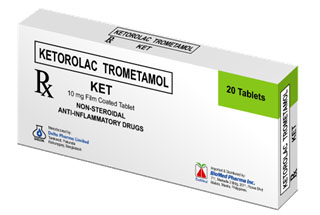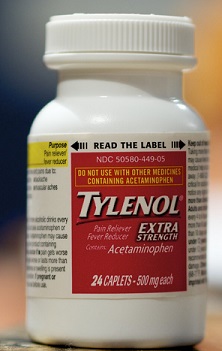Contents
Why is Ketorolac prescribed
Ketorolac is a Generic name for a non-steroidal anti-inflammatory drug (NSAID) with pyrrolizine structure containing salt ketorolac tromethamine as an active ingredient, that is used as an anti-inflammatory agent with analgesic and antipyretic properties for the management of osteoarthritis and moderately severe acute pain that needs analgesia at the opioid level, usually in a postoperative patients.
It is a peripherally acting analgesic. Ketorolac is available in a form of solution and injection for intramuscular route in doses of 15 mg/ml and 30 mg/ml, as an ophthalmic solution in doses of 4, 4.5 and 5 mg/ml, as and intravenous solution in doses of 15, 30 and 60 mg/ml and as a film coated tablet in the dose of 10 mg.
Ketorolac tromethamine in tablet and intramuscular dosage forms is a racemic mixture of both (S)-(−)-ketorolac, the active isomer with analgesic properties, and (R)-(+)-ketorolac.
An ophthalmic solution is used to treat eye pain and to relieve the burning and itchiness caused by seasonal allergies. It is usually taken every 4 to 6 hours on a schedule or as needed for pain.
Common Brand names on the market containing ketorolac tromethamine as an active ingredient are: Bedoral, Dolten, Emodol, Etorac, Ketora, Ketonic, Syndol, Lixidol, Toradol and Tarasyn.
Why Tylenol after surgery
Tylenol is a Brand name for a drug that contains acetaminophen (also known as paracetamol) that has antypiretic and analgesic properties.
It is used for reducing pain and fever and also for relieving the symptoms of common cold, cough, headache, toothache, allergies and influenza. Usual per oral doses for Tylenol are 325-650 mg. It is available in tablets, caplets and liquid dosage forms.
Tylenol products on the market are: Tylenol Extra Strength Caplets, Tylenol Regular Strength Tablets, Tylenol 8 HR Extended-Release Caplets, Tylenol 8 HR Arthritis Pain, Tylenol Sinus Congestion & Pain Caplets, Tylenol Cold Multi-Symptom Caplets and Liquid, Tylenol Cold Head Congestion Severe Caplets, Tylenol PM Caplets and Tylenol Cold Sore Throat Liquid.
Tylenol Extra Strength are caplets containing only Acetaminophen 500mg as an active ingredient that is used as a pain reliever/fever reducer.
Tylenol Cold are also caplets containing: Acetaminophen 325mg as a pain reliever/fever reducer, Dextromethorphan 10mg as a cough suppressant and Phenylephrine HCl 5mg as a nasal decongestant.
Tylenol Sinus is another Tylenol product that is used for relieving the symptoms of: sinus headache, sinus pain and pressure, sinus congestion, aches and pain and runny nose and sneezing (in Nighttime only).
It is available in tablet form containing: acetaminophen 500 mg as a pain reliever/fever reducer and phenylephrine hydrochloride, 5 mg as a nasal decongestant, and chlorpheniramine maleate 2mg as an antihistamine.
Tylenol-Codeine is a combination of acetaminophen 500 mg and codeine 8 mg that is used for relieving mild to moderate pain, fever reduce and as a cough suppressant.
How does Ketorolac and Tylenol work in the body
Ketorolac tromethamine is a racemic mixture of [+]R- and [-]S- enantiomers, with the S-form containing analgesic activity. This drug works by inhibiting both cyclooxygenase enzyme, COX-1 and COX-2, leading to the inhibition of prostaglandin synthesis, decreased formation of precursors of prostaglandins and thromboxanes.
Analgesic effects are probably produced through peripheral action in which impulse signaling blockage results from decreased prostaglandin activity.
However, analgesic effects may be also contributed through the inhibition of actions or synthesis of other body substances that can sensitize receptors responsible for pain due to mechanical or chemical stimulation.
After ocular administration, ketorolac reduces prostaglandin E2 levels in aqueous humor, secondary to inhibition of prostaglandin biosynthesis.
Acetaminophen is highly selective COX-2 inhibitor that inhibits prostaglandin synthesis. It can inhibit COX-2 in CNS. Acetaminophen also acts on the hypothalamic heat regulating centers to produce antipyresis.
Acetaminophen’s reactive metabolite N-acetyl-p-benzoquinone imine (NAPQI) can cause a potentially fatal, hepatic necrosis through the process of lipid peroxidation if acetaminophen is overdosed (more than 4g daily).
Dextromethorphan acts on cough center in medulla by decreasing sensitivity of cough receptors and by interrupting impulse transmission.
Phenylephrine is sympathomimetic with direct action on the adrenergic receptor system. The vasoconstriction is produced after α-adrenergic receptors activation.
Chlorpheniramine is antagonist of histamine H1 receptor. It has been also shown that this drug is also a serotonin-norepinephrine reuptake inhibitor.
Codeine is an opioid analgesic which is chemically related to morphine but it has less potent analgesic properties and mild sedative effects. It also acts suppress cough by centrally mechanisms.
Can patients take Ketorolac and Tylenol together
Patients need to consult with their doctor first before they take these medicines together. Tylenol and Ketorolac are both NSAID drugs and have similar pharmacologic effects, so if patients take them together, they may increase the risk of side effect to happen.
The risk will depend on how much of each medicine patients take every day, and on how long they take these medications together. Doctor may prescribe these drugs together for the treatment of migraine or fever associated with inflammation, but patients should not take them for more than a few days.
Ketorolac may also cause dizziness or drowsiness and antihistamines or antitussive drugs that can be found in Tylenol products can add these side effects .
Therefore, patients should avoid taking Ketorolac together with Tylenol products containing combination of acetaminophen and drugs such as chlorpheniramine, diphenhydramine, dextromethorphan or codeine.
The table below shows side effects after Ketorolac and Tylenol administration in recommendable doses. The incidence can be significantly increased if these drugs are overdosed or taken together.
| Very common side effects >10% | Headache (17%), Dyspepsia (12-13%), Nausea (12-13%), GI pain (12-13%), Somnolence (3-14%) |
| Common side effects 1-10% | Dizziness (3-9%), Diarrhea (3-9%), Pruritus (3-9%), Drowsiness (6%), Hypertension (4%), Constipation (<3%), Purpura (<3%), Increased blood urea nitrogen (BUN) (3%), Edema (1-3%), Increased serum creatinine (2%) |
| Frequency Not Defined | Disorientation, Angioedema, Gastrointestinal hemorrhage, Laryngeal edema, Pruritic maculopapular rash, Hyperammonemia, Leukopenia, Neutropenia, Pancytopenia, Thrombocytopenia, Agranulocytosis, Stevens-Johnson syndrome, Toxic epidermal necrolysis, Urticaria, , Thrombocytopenic purpura, Hepatotoxicity, Liver failure, Nephrotoxicity, Pneumonitis |
Special precautions and warnings during Ketorolac and Tylenol administration:
- Patients should tell their doctor and pharmacist if they are allergic to ketorolac or acetaminophen, or any other medicines, or any of the ingredients that are used in these products.
- Patients should tell their doctors or pharmacists what prescription and nonprescription medicines, vitamins or nutritional supplements they are taking or plan to take while taking these drugs. Patients using ketorolac should tell their doctor if they are using any of the following drugs: medications for anxiety or mental illness; antidepressants; medications for seizures such as carbamazepine or phenytoin, methotrexate, sedatives; sleeping pills or tranquilizers. Patients taking Tylenol should mention if they are taking some of the following drugs: enalapril, fosinopril, lisinopril, benazepril, captopril, moexipril diuretics, lithium and methotrexate. Doctor may need to change the doses of these medications or monitor more carefully for side effects.
- Patients should tell their doctor if they have or have ever had kidney or liver disease.
- Patients should avoid alcohol while using these medications. Drinking alcohol can increase certain side effects of Ketoralac and Tylenol. Alcohol may increase the risk of liver damage while taking Tylenol.
- Acetaminophen overdose can lead to acute liver failure. Acetaminophen administration shouldn’t exceed the doses of 4g per day.
- Patients should tell their doctor if they have ever had a rash while taking acetaminophen.
- Patients with phenylketonuria should avoid these medicines.
- Patients should also know that combination acetaminophen products for cough and colds containing cough suppressants expectorants, nasal decongestants and antihistamines, should not be used in children younger than 2 years of age. In children 2 through 11 years of age such combinations should be used carefully and only according to the directions on the label.
- Tylenol can cause unusual results with certain laboratory tests for glucose in the urine.
- Patients should avoid becoming dehydrated or overheated during exercises. Chlorpheniramine can decrease sweating and patients could become more prone to heat stroke
- Patients should avoid these medications if they also take caffeine pills, diet pills, or other stimulants. Taking decongestants (pseudoefedrine, phenylephrine) together with stimulants can increase the risk of unpleasant side effects
- Ketorolac shouldn’t be used for more than 5 days, because it can cause gastrointestinal side effects.
- Patients using Ketorolac should tell their doctor if they have or have ever had: swelling of the hands, ankles, lower legs or feet.
- Women on Ketorolac therapy should tell their doctor if they are pregnant, especially if they are in the last trimester of their pregnancy, or if they plan to become pregnant. If they become pregnant while taking ketorolac, they should call their doctor.
- Older adults (65 or older) should not usually take ketorolac because it is not as safe as other drugs that can be used to treat the same conditions.
- Ketorolac may make patients drowsy or dizzy. They shouldn’t drive a car or operate machinery while using this medicine
“Can you take Ketorolac and Oxycodone together?“
“Tylenol Vs Ibuprofen“


